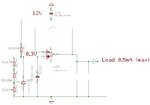T
treez
Guest

Hi
We wish to have this 8V3 Regulator. (attached)
Do you think the amount of output capacitance will make the MIC6211 opamp go unstable?
MIC6211 opamp
https://ww1.microchip.com/downloads/en/DeviceDoc/mic6211.pdf
We wish to have this 8V3 Regulator. (attached)
Do you think the amount of output capacitance will make the MIC6211 opamp go unstable?
MIC6211 opamp
https://ww1.microchip.com/downloads/en/DeviceDoc/mic6211.pdf







